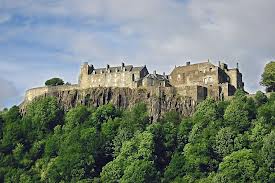



photo by Finlay McWalter
The sieges of Stirling castle are not to be confused with the Battle of Stirling Bridge, which played such a significant role in the battle for Scotland's independence from England.
There have been at least eight sieges of Stirling Castle, a strategically important fortification in Stirling, Scotland. Stirling is located at the crossing of the River Forth, making it a key location for access to the north of Scotland. The castle changed hands several times between English and Scottish control during the Wars of Scottish Independence (1296-1357).In 1299, the castle was in English hands, when the constable, John Sampson, was besieged by the Scots. In 1304, Edward I of England besieged the Scots, deploying siege engines to force the garrison to surrender. In 1337, a siege by Sir Andrew Murray failed to retake the castle. Between 1571 and 1585, the castle was besieged three times by Scots factions during the reign of King James VI, of Scotland. In 1651, Oliver Cromwell captured the castle during his invasion of Scotland. The final siege took place in 1746, when Charles Edward Stuart besieged the castle during the final Jacobite Rebellion.
The Carruthers clan were present at the November 2, 1585 Siege of Stirling. George Carruthers, 2nd Baron Holmains and 6th laird, was in command along with John Maxwell, Provost of Dumfries, of 3 companies of infantry and 2 troops of cavalry. This force was comprised of Carruthers, Bells and Irvines. It included George's son Charles, who was a Cornet in the mounted garrison at Threave castle. (It was normally the practice of the Bells of Middlebie to rally under the standard of Carruthers of Mouswald). Overall command that day was under Lord Maxwell.
Family Name Christmas GiftsClick on the item below for merchandise with the family name or crest
Related Names To request another name - email webmaster@carothers-carruthers.com |
||
Search This Site by Keyword |
||
** Records of the Carruthers Family **The book Records of the Carruthers Family is now available in serialized .pdf form from this web site. New sections will be added monthly. Click on the above link to go to the page with the sections. |
||
|
|
||
|
Genealogists |
||
|
|
||
|
||||||||||
|
|
||
Sponsored Links |
||
Site Map - Click "+" to see all pages |
||
webmaster@carothers-carruthers.com


